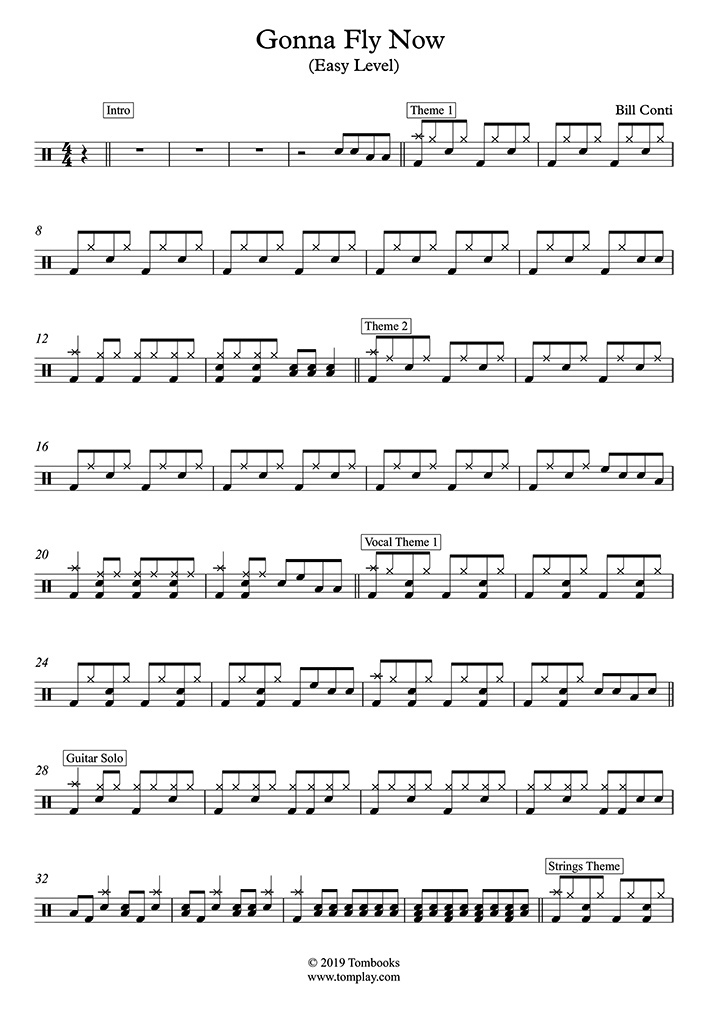
Our catalogue features 2 arrangements of Dynasty (Theme), available for purchase for 2 instruments. If you fancy letting others know how much you enjoyed playing this piece or arrangement then click on the share button on this page and select the appropriate social media which you would like to use. We offer the facility for you to share this song page with the world. In order to achieve this, please click on the drop-down box called "Instrument" and alter the selection.ĭo you really love a particular arrangement that we have of this song and would you like to extol its virtues? In that case please move your mouse to the section entitled Comments, and after choosing a user name you may leave your musings on this page for all to see. Should this composition be available for a number of different instruments, then you have the option to view arrangements for just one specific instrument.
#How to play the rocky theme song on piano tv
Dynasty (Theme) is a Bill Conti, TV Theme Song composition.Ĭlick on our preview button to see the first page of Dynasty (Theme). In Hooktheory's color notation, non-diatonic notes are labeled with hashed colors.All our available scores for the composition Dynasty (Theme) are displayed on this page. Often these “non-diatonic” notes create dissonance that isn’t available within the normal diatonic notes and require more care in creating a melody that is coherent. For this reason, melodies that use notes outside of the scale create an added complexity. In either case, it’s almost certain that most of the melodies that you know by heart are based on the 7 notes in one of these scales. Whether these scales are simply cultural artifacts stemming from centuries of music doing it this way or rather they are derived from something more fundamental (falling naturally from the laws of nature) is a topic of continued debate. The lyrics intrigued and puzzled fans, even as the song ascended to the top of the charts. In “Western” music - a label that describes the bulk of popular music - melodies are based on 7-note scales called “diatonic” scales, like the Major or Minor scales. Michael Martin Murpheys Wildfire, released in 1975, tells the story of a man who is haunted by the ghost of a young woman, possibly Native American, who died while riding her horse Wildfire in a blizzard. Other examples of chords that contain non-sacle tones are secondary chords, and chords with certain non diatonic alterations (#5, b9, etc.).Ī melody, at its heart, is a sequence of notes sung or played with specific timings. Using an F minor chord in a chord progression that is in the key of C major will sound more complex because our ears simply aren’t expecting it (the same is true for using an F Major chord in a song that is in the key of C Minor). If instead, we consider the key of C Minor, the 4th chord is an F minor chord. For example, in the key of C major, the 4th chord is normally an F major chord. Chords that do this are often called borrowed chords because they are using tones they’ve “borrowed” from a different scale. Our ears naturally expect to hear notes in the scale so chords with non-scale tones tend to sound more exotic and complex. The second factor we look at is whether a chord contains notes that lie outside of the scale of the song's key. Songs that have these chords in them will be judged to have more chord complexity than one that does not.

Other examples of chords with extra notes are Sus2/Sus4 chords, and add9, 9th chords. 7ths are more dissonant than the 3rds and 5ths of the plain C chord, and so our ears perceive this as more complex. The nature of the intervals is changed as well C - B is called a 7th (as there are 7 notes counting from C to B along the scale), and this interval didn’t exist previously. In addition to the intervals C - E, E - G, C - G, we now have twice as many when we add C - B, E - B, G - B. A Cmaj7 chord, for example, is similar to a plain C chord, except it has an additional note: B. Adding notes to a chord increases its complexity because it increases the number and nature of intervals or note interactions that our ear must process. The first is whether the chords contains additional notes beyond the 3 that form the primary chords described above.

There are fundamentally two metrics that we consider when judging the complexity of a chord relative to the basic ones above.


 0 kommentar(er)
0 kommentar(er)
